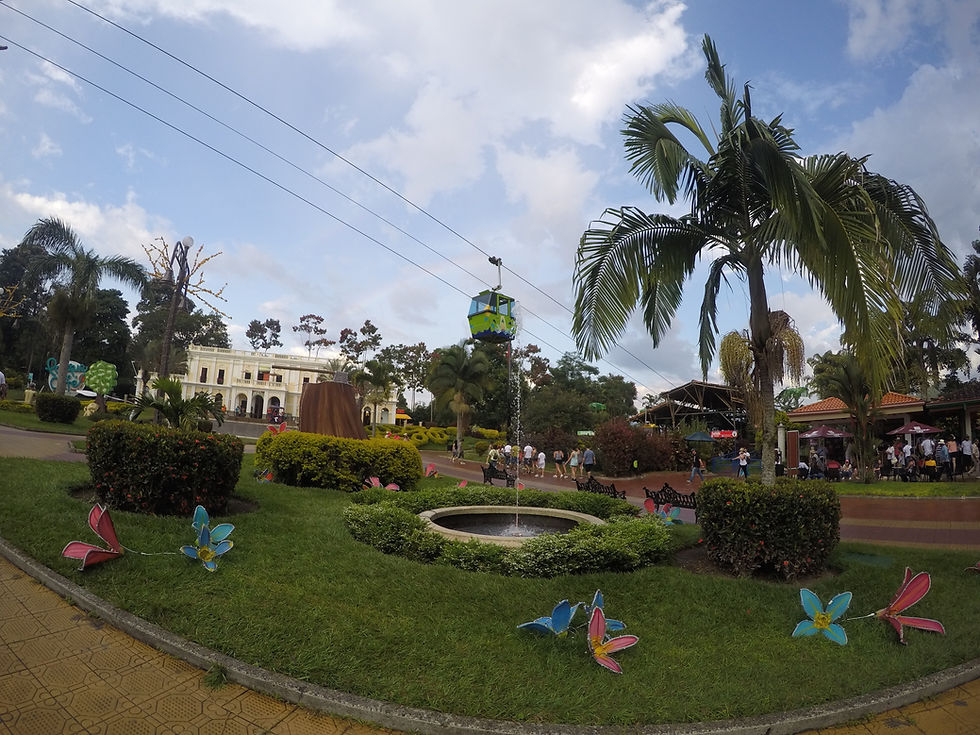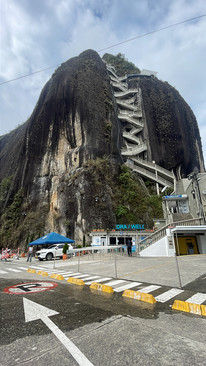Towns in Colombia - Places to Visit Instead of Bogotá & Medellín
- Sinéad Morrissey
- Feb 7, 2024
- 10 min read
Updated: Jul 2
Colombia is full of charm. Beyond the buzz of Bogotá, Medellín and Cartagena, there are countless small towns that offer an authentic experience. Perfect for travellers looking to slow down and really connect with the country and it's culture.
Here we'll explore some of the most beautiful towns in Colombia, tips on how to get there and things to do when you get there to make the absolute most of your stay.
Mongui:
Situated in the Boyacá region, Mongui is a hidden gem known for its breathtaking landscapes and well-preserved colonial architecture. The Basilica de Mongui stands as a testament to the town's rich history, while the cobbled streets invite visitors to wander and discover the town's quaint charm. Hiking to the Pueblito Boyacense viewpoint offers panoramic views of the surrounding hills.
Department: Boyacá
Altitude: 2,900 metres (9,514 ft)
Weather and climate: Cool and crisp year-round. Temperatures range from 5°C to 18°C (41°F to 64°F). Expect misty mornings and occasional rainfall. Pack layers and a waterproof jacket.
How to get there: To get there from Bogotá, take a bus via Sogamoso or drive for approximately 5 hours. From Medellin bus to Tunja and then take a bus to Mongui. From Cartagena, travellers can fly to Bogotá and take a bus via Sogamoso.
Things to do: Visit the Basilica de Mongui, explore the cobbled streets, and hike to the Pueblito Boyacense viewpoint.
Ideal for: Nature lovers and architecture aficionados.
Fun fact: Monguí is famous for producing handcrafted footballs and was once one of Colombia’s primary suppliers of leather soccer balls!
Tip: Don't miss the sunset at the Pueblito Boyacense viewpoint; the breathtaking views of the town and surrounding landscapes are magical.
Lake Tota:
Crowned as the largest freshwater lake in Colombia, Lake Tota (Laguna de Tota) captivates visitors with its deep blue waters, soft white-sand beach at Playa Blanca, and lush highland surroundings. At over 3,000 metres above sea level, this scenic destination blends cool mountain air with spectacular views. Nearby towns like Aquitania, known for its onion farms and lake views, Tibasosa with its colonial charm and feijoa treats, and the cultural hub of Sogamoso offer warm hospitality and local flavour. Ideal for nature lovers, Lake Tota is a serene escape tucked into the Andes.
Department: Boyacá
Altitude: 3,015 metres (9,892 ft)
Weather and climate: Cold highland climate with frequent fog and wind. Temperatures range from 2°C to 16°C (36°F to 61°F). Dress in layers—mornings and evenings are chilly.
How to get there: From Bogotá, take a bus to Sogamoso (approx. 4 hours), then continue by taxi or local transport/collectivo to Lake Tota (about 45 minutes). Travellers from Medellín can fly to Bogotá and then take a bus to Sogamoso, or drive directly in around 9–10 hours. From Cartagena, fly to Bogotá and continue by road.
Things to do: Visit the Pueblito Antiguo, relax at Playa Blanca (only open to the public during weekends and public holidays), take a boat ride or kayak on the lake, enjoy fresh trout at lakeside restaurants, explore Aquitania and Tibasosa, or go hiking and birdwatching in the surrounding hills.
Ideal for: Nature lovers, couples, and travellers seeking a peaceful mountain retreat.
Fun fact: Playa Blanca on Lake Tota is one of the highest altitude beaches in the world and it has real white sand!
Tip: Visit early in the day for the clearest skies and calmest waters. Don’t forget a jacket—the weather can change quickly in the highlands.
Barichara:
A colonial gem, Barichara is a time capsule with cobblestone streets, colourful houses, and a peaceful ambience. The town's well-preserved architecture, including the Santa Barbara Church, transports visitors to a bygone era. Barichara is perfect for those seeking a tranquil escape, where leisurely strolls through charming streets and hikes along the Camino Real are a must.
Department: Santander
Altitude: 1,336 metres (4,383 ft)
Weather and climate: Pleasantly warm and dry. Daytime temperatures hover between 20°C and 28°C (68°F to 82°F). Rainfall is light, with more showers from April to October.
How to get there: From Bogotá, take a direct bus for about 7 hours. Medellin visitors can fly to Bucaramanga and then take a bus via San Gil to Barichara. Cartagena travellers can follow the same route to Bucaramanga and then take a bus via San Gil to Barichara.
Things to do: Wander through the charming streets, visit the Santa Barbara Church, and hike the Camino Real.
Ideal for: History buffs and those seeking a relaxed tranquil escape.
Fun fact: The town's name means “place of rest” in the Guane language—and it truly lives up to it with its peaceful vibe and slow pace of life.
Tip: Rise early to experience the charm of Barichara's cobblestone streets before the day unfolds; it is a great opportunity to snap gorgeous photos of your trip.

Raquira:
Known as the "City of Pots," Raquira is a vibrant town celebrated for its pottery and crafts. Artisan workshops offer visitors the chance to witness the creation of exquisite handmade pieces. The Iglesia de San Antonio adds a touch of colonial history to the town, making Raquira an ideal destination for art enthusiasts and those looking for unique souvenirs.
Department: Boyacá
Altitude: 2,150 metres (7,054 ft)
Weather and climate: Mild and temperate. Average temperatures range from 10°C to 20°C (50°F to 68°F). Occasional light rain, especially during April–May and October–November.
How to get there: To reach Raquira from Bogotá, take a bus for approximately 4 hours. From Medellin, take a bus for 6.5 hours. Cartagena travellers can fly to Bogotá and follow the same route.
Things to do: Explore the artisan workshops, shop for handmade crafts, and visit the Iglesia de San Antonio.
Ideal for: Art enthusiasts and souvenir collectors.
Fun fact: Ráquira’s name comes from the Chibcha language and means “City of Pots.” Its pottery tradition dates back to pre-Colombian times.
Tip: Engage with local artisans in Raquira to gain insights into their craft and perhaps even try your hand at pottery – a hands-on experience that adds a personal touch to your visit.
Salento:
Nestled in the heart of the Coffee Triangle, Salento is a colourful town surrounded by lush landscapes and coffee plantations. The Cocora Valley, with its towering wax palms, is a natural wonder awaiting exploration. Calle Real invites visitors to meander through vibrant streets, while the Mirador Alto de la Cruz provides breathtaking views of the town and its surroundings.
Department: Quindío
Altitude: 1,895 metres (6,217 ft)
Weather and climate: Subtropical highland climate with frequent rain. Temperatures range from 12°C to 22°C (54°F to 72°F). Rain showers are common year-round, especially in the afternoons.
How to get there: From Bogotá, take a direct bus for around 7 hours. Medellín visitors can take a bus to Salento. Cartagena travellers can fly to Pereira and follow the same route.
Things to do: Explore the Cocora Valley, stroll along Calle Real, and hike to the Mirador Alto de la Cruz.
Ideal for: Nature lovers and coffee enthusiasts.
Fun fact: Salento is the gateway to the Cocora Valley, home to Colombia’s national tree, the wax palm, the tallest palm in the world.
Tip: Take a guided coffee plantation tour in the surrounding area to learn about the coffee-making process and savour freshly brewed Colombian coffee amid the picturesque landscapes.

Honda:
Situated on the banks of the Magdalena River, Honda is a colonial gem with well-preserved architecture and a rich history. Riverboats offer a unique perspective of the town, allowing visitors to appreciate the scenic beauty along the Magdalena. The Puente Navarro and the historic Candelaria neighbourhood add to the allure, making Honda an ideal destination for history enthusiasts and river adventure seekers.
Department: Tolima
Altitude: 225 metres (738 ft)
Weather and climate: Hot and humid tropical climate. Average temperatures sit between 25°C and 35°C (77°F to 95°F). Expect intense sun and occasional thunderstorms, particularly from April to October.
How to get there: To reach Honda from Bogotá, take a bus for approximately 4 hours. From Medellin take a bus approx. 5-6 hours. Cartagena travellers can fly to Bogotá and take a bus in approximately 6 hours.
Things to do: Take a riverboat tour, visit the Puente Navarro, and explore the historic Candelaria neighbourhood.
Ideal for: History enthusiasts and river adventure seekers.
Fun fact: Known as the “City of Bridges,” Honda has over 40 bridges connecting its colonial streets across the Magdalena River and surrounding valleys.
Tip: Opt for a riverboat tour during the golden hours of sunrise or sunset to witness the stunning colours reflected on the Magdalena River.
Santa Cruz de Mompox:
A UNESCO World Heritage Site, informally known as Mompox, is a colonial town frozen in time along the banks of the Magdalena River. Plaza de la Concepción, the Santa Bárbara Church, and boat trips to the Ciénaga de Pijiño provide glimpses into the town's historical and natural treasures. Mompox is perfect for those seeking a tranquil riverside escape and a deep dive into Colombia's colonial past.
Department: Bolívar
Altitude: 20 metres (66 ft)
How to get there: To get there from Bogotá, take a bus for approximately 10 hours. From Medellin, fly to Cartagena and then take a bus for 5.5 hours to Mompox.
Things to do: Explore the Plaza de la Concepción, visit the Santa Bárbara Church, and take a boat trip.
Ideal for: History buffs and those seeking a tranquil riverside escape.
Fun fact: Gabriel García Márquez drew inspiration from Mompox for his magical realist settings. The town is often considered a real-life Macondo.
Tip: Explore Mompox on foot, allowing yourself to get lost in the cobblestone streets and discover hidden gems that may not be found in guidebooks.
Filandia:
Tucked away in the Coffee Triangle, Filandia is a hidden gem known for its vibrant architecture and stunning landscapes. The town's colourful facades create a picturesque setting for exploration. The Coffee Cultural Landscape House offers insights into the region's coffee heritage, and nearby hikes in Los Nevados National Natural Park provide outdoor adventures for nature lovers.
Department: Quindío
Altitude: 1,923 metres (6,309 ft)
Weather and climate: Hot, humid, and tropical. Daily temperatures stay between 27°C and 34°C (81°F to 93°F). Rain is frequent between April and November, with drier months from December to March.
How to get there: From Bogotá, take a bus for approximately 6 hours. Medellin visitors can take a bus for approx. 4 hours. Cartagena travellers can fly to Pereira and follow the same route.
Things to do: Admire the vibrant facades, visit the Coffee Cultural Landscape House, and hike in the Los Nevados National Natural Park.
Ideal for: Photography enthusiasts, foodies and nature lovers.
Fun fact: Filandia's name is said to mean “Daughter of the Andes.” Its lookout tower offers one of the most breathtaking 360° views in the Coffee Region.
Tip: Capture the vibrant facades of Filandia in the soft morning light for the most stunning photographs of this colourful town.

Guatapé:
Famed for its vibrant zocalos, Guatapé is a picturesque town surrounded by lakes and hills. The town's lively atmosphere, coupled with the opportunity to climb El Peñol rock, makes it a popular destination. Exploring the vibrant streets, taking boat tours on the Guatapé Reservoir, and soaking in the local culture are highlights for outdoor enthusiasts and those seeking a lively atmosphere.
Department: Antioquia
Altitude: 1,925 metres (6,316 ft)
Weather and climate: Dry and sunny with cool nights. Temperatures fluctuate between 10°C and 24°C (50°F to 75°F). Rain is occasional, with a drier climate than much of Boyacá.
Weather and climate: Mild and humid with regular rainfall. Daytime temperatures range from 15°C to 22°C (59°F to 72°F). Rain showers are common, but interspersed with sunny spells.
How to get there: To reach Guatapé from Bogotá, take a bus for around 6.5 hours. From Medellin, take a bus for approximately 2 hours. Cartagena travellers can fly to Medellin and follow the same route.
Things to do: Climb the El Peñol rock, explore the town's vibrant streets, and take a boat tour on the Guatapé Reservoir.
Ideal for: Outdoor enthusiasts and those seeking a lively atmosphere.
Fun fact: Guatapé’s colourful zócalos (bas-relief tiles) on houses depict stories of the town’s history, tradition and even jokes shared by locals!
Tip: Climb El Peñol rock early in the morning to avoid the midday heat and enjoy panoramic views with fewer crowds.
Villa de Leyva:
Crowned as the most beautiful town in Colombia, Villa de Leyva enchants visitors with its cobblestone streets, colonial architecture and expansive Plaza Mayor. The Fossil Museum and hikes to the Iguaque Sanctuary offer cultural and natural experiences. This peaceful retreat, ideal for cultural enthusiasts, provides a serene escape into Colombia's rich history and tranquil surroundings.
How to get there: To get there from Bogotá, take a bus for around 4 hours. Medellin visitors can take a bus for around 12.5 hours or drive in approx. 7 hours. Alternatively, visitors from Medellín can fly to Bogotá and take a bus to Villa de Leyva. Cartagena travellers can also fly to Bogotá and take a bus.
Department: Boyacá
Altitude: 2,149 metres (7,051 ft)
Weather and climate: Mild and cloudy much of the year with sunny afternoons. Temperatures range from 10°C to 22°C (46°F to 68°F). Rain is common, so bring an umbrella or rain jacket.
Things to do: Visit the Plaza Mayor, explore the historical town filled with Galleries & Museums, and hike to the Iguaque Sanctuary.
Ideal for: Cultural enthusiasts and those longing for a peaceful retreat.
Fun fact: Villa de Leyva's massive Plaza Mayor is one of the largest town squares in South America, covering 14,000 square metres.
Tip: Take a leisurely stroll around Plaza Mayor in the evening when the surrounding colonial buildings are beautifully illuminated and surrounded by the mountains.
Zipaquira:
Nestled in the Andean region of Colombia, Zipaquira is home to the mesmerising Salt Cathedral (Catedral de Sal), an underground marvel carved within a salt mine. The town itself boasts a charming centre with colonial architecture, providing a unique blend of history and natural wonders. Visitors can explore the intricately designed cathedral and indulge in local delicacies.
Department: Cundinamarca
Altitude: 2,650 metres (8,694 ft)
Weather and climate: Mild and cloudy much of the year. Temperatures range from 8°C to 20°C (46°F to 68°F). Afternoon rain is common, so bring an umbrella or rain jacket.
How to get there: To reach Zipaquira from Bogotá, take a one-hour bus ride or a private car. Medellin and Cartagena travellers can fly to Bogotá and then follow the same route.
Things to do: Explore the Salt Cathedral, stroll through the charming town centre and sample local food.
Fun fact: The Salt Cathedral of Zipaquirá is carved entirely out of salt and lies 200 metres underground, it's even hosted concerts.
Ideal for: History enthusiasts and those seeking an spiritual experience.

To conclude, Colombia's beautiful towns offer a diverse tapestry of landscapes, history and culture. Whether you're drawn to ancient wonders, colonial charm, or natural beauty, each town on this countdown provides a unique experience. Embark on a journey off the beaten path and discover the magic that awaits in Colombia's enchanting towns.
























































Comments